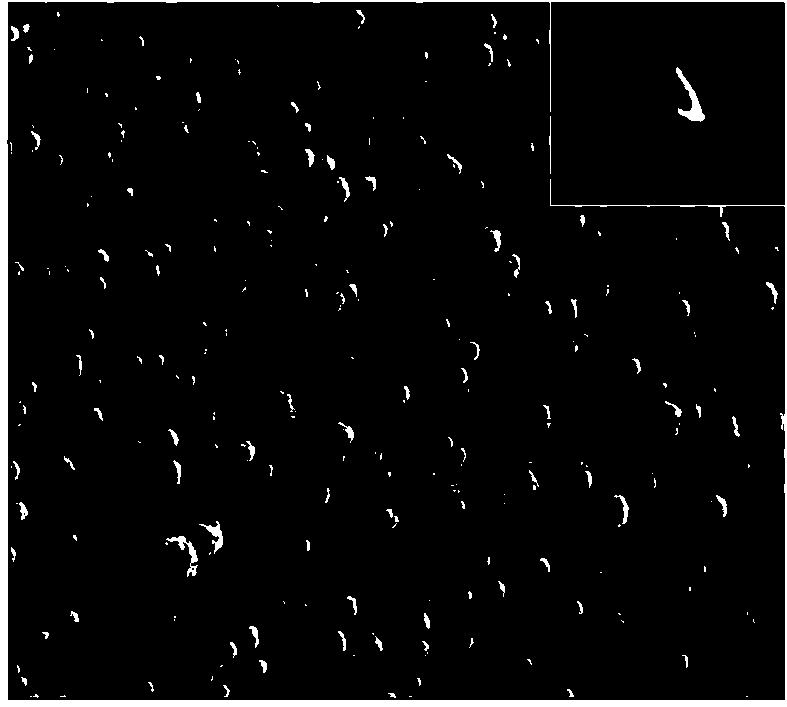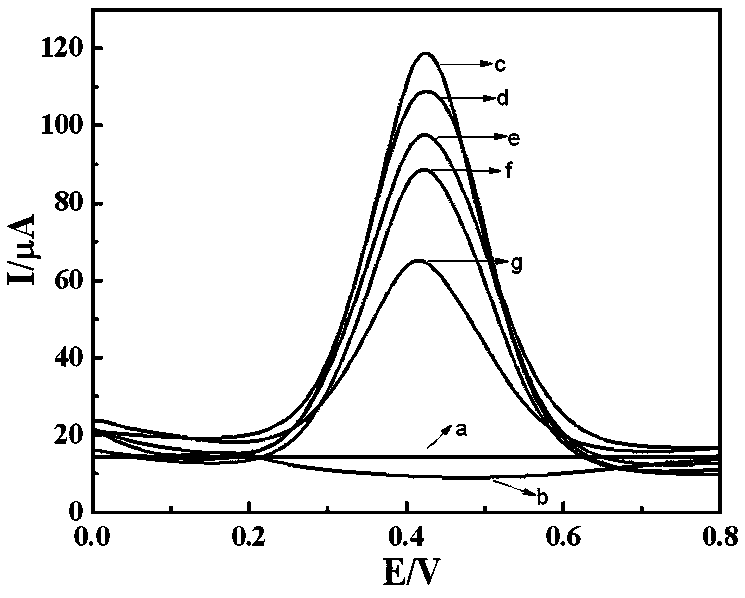Electrochemical aptamer sensor for detecting atrazine, and preparation and detection methods for sensor
An aptamer sensor and atrazine technology, applied in the direction of electrochemical variables of materials, etc., can solve the problems of reduced analytical performance, cumbersome operation, poor selectivity, etc., and achieve simple equipment, low analysis cost, and high selectivity. Effect
- Summary
- Abstract
- Description
- Claims
- Application Information
AI Technical Summary
Problems solved by technology
Method used
Image
Examples
Embodiment 1
[0036] This embodiment proposes a method for preparing an electrochemical aptasensor for detecting atrazine, comprising the following steps:
[0037] S101. Pretreatment of the glassy carbon electrode GCE.
[0038] Glassy carbon electrodes GCE were used with 1.0, 0.3, 0.05 µm Al 2 o 3 After powder polishing, ultrasonically clean in ethanol and high-purity water for 1 to 5 minutes, and finally in N 2 The atmosphere is dry.
[0039] S102, preparation of ERGO / GCE electrodes.
[0040] Place the treated glassy carbon electrode GCE in a pure aminopropyl triethoxy silicon solvent with a purity of 98% and immerse it for 20-30 minutes, aminate the surface of the glassy carbon electrode GCE, then rinse it with secondary water, and Dry in N2 atmosphere until the surface of the electrode is free of water beads and becomes a smooth mirror surface.
[0041] Then, 1 mg / L graphene oxide GO solution was drop-coated on the surface of the surface-aminated glassy carbon electrode GCE, and dri...
Embodiment 2
[0051] This embodiment provides a detection method for an electrochemical aptasensor for detecting atrazine, comprising the following steps:
[0052] S201, preparing a plurality of atrazine standard solutions with different concentrations;
[0053] S202. Using the electrochemical aptamer sensor for detecting atrazine as a working electrode, a saturated calomel electrode as a reference electrode, and a platinum sheet electrode as a counter electrode, in an electrolyte solution of 0.1 M PBS, pH7.4 Atrazine was determined by differential pulse voltammetry. Due to the specific recognition of the aptamer and its target substance, atrazine interacts with the nucleic acid aptamer modified on the electrode surface, and atrazine is captured on the electrode surface to form an aptamer-atrazine The complex prevents the electron transfer between the solution and the electrochemical sensing interface, resulting in a decrease in the redox peak current of the nickel-ferricyanide complex nan...
Embodiment 3
[0057] Using 0.1 M PBS solution (pH 7.4) as the electrolyte solution, the prepared electrochemical aptamer sensor was used as the working electrode, the saturated calomel electrode was used as the reference electrode, and the platinum electrode was used as the counter electrode. Somatosensor selectivity for atrazine. Prepare samples of the substance to be tested, atrazine, and interfering substances (the concentration of the interfering substances is 100 times that of atrazine), and the interfering substances are simazine, propanil, malathion, 2,4- D. A mixed solution of p-nitrophenol, 2,2-binaphthol, bisphenol A and all above-mentioned interfering substances and atrazine. Using the test conditions in Example 2, the above solutions were respectively added into the test system, and the differential pulse method was used for detection.
[0058] Such as Figure 5 As shown, first, the sensor prepared by the above method is used to detect atrazine (the first bar graph), and then ...
PUM
 Login to View More
Login to View More Abstract
Description
Claims
Application Information
 Login to View More
Login to View More - R&D
- Intellectual Property
- Life Sciences
- Materials
- Tech Scout
- Unparalleled Data Quality
- Higher Quality Content
- 60% Fewer Hallucinations
Browse by: Latest US Patents, China's latest patents, Technical Efficacy Thesaurus, Application Domain, Technology Topic, Popular Technical Reports.
© 2025 PatSnap. All rights reserved.Legal|Privacy policy|Modern Slavery Act Transparency Statement|Sitemap|About US| Contact US: help@patsnap.com



